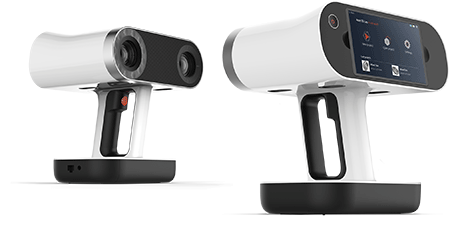
Heralding what its company president and CEO describes as “the next wave of the 3D scanning industry”, the Artec 3D Leo is the first to use AI algorithms to capture and automatically processes huge amounts of data, all on a single device.
Building on last year’s release of Autopilot – an AI-based feature within the Artec Studio 11 software that automatically processes raw 3D data into 3D models – Leo is the first to autonomously select and process data onboard, without connecting to a tablet or computer.
Built on Nvidia’s Jetson platform, the Artec Leo, the scanner captures data at up to 80 frames per second, using a 9 degrees of freedom inertial system (accelerometer, gyro and compass)to provide precise information about its position and environment.

The mobile scanner has 256 Gb of inbuilt storage, and built in battery pack
This enables the device to understand the difference between the object being scanned, the surface it is on and the wall behind it, automatically erasing the unwanted data.
On it’s multi-touch, half HD screen, a user can watch while their object is digitised into a full color 3D model in real time.
A built-in SSD drive can store 256 Gb of captured data, while micro SD cards can be used to extend the capacity of the device.
The unit also includes a built-in battery pack, ergonomic grip, and balanced design for easy wireless operation and allows it to access traditionally hard-to-reach locations.
“Artec Leo embodies the next wave of the 3D scanning industry,” said Artec 3D president and CEO Artyom Yukhin. “It is intuitive, mobile, and using our AI algorithms, it captures and automatically processes huge amounts of data, all on a single device that requires minimal training to master.
“Leo’s next-generation platform is a massive breakthrough in the industry and we intend to build upon this success to expand our line of smart 3D scanners.
“Our goal is to make professional 3D scanning as easy as shooting video for any industry and the Artec Leo is the next big step in achieving that goal.”
“Our Jetson embedded computing platform pushes the limits of visual and AI computing and, through our work with Artec, real-time 3D capture, modeling and visualisation is now possible in a handheld scanner,” said Lazaar Louis, product management lead for Tegra and business development for VR/AR products at Nvidia.
“This is important for a wide variety of industries, including industrial design and manufacturing, healthcare, science, education, animation, and computer graphics.”
Utilising a proprietary two-in-one optics system, with a 3D camera and color camera combined as one, the Artec Leo can achieve precision in texture mapping at a resolution of 2.3 mp.
High quality geometry is also achieved, thanks to the use of a VCSEL light source, which allows for capturing objects in bright, outside conditions, which has allowed Artec 3D to create a flash system that can be adjusted based on the surrounding light conditions for enhanced 3D capture.
This also enables users to scan in 3D HDR, making it easier to capture tricky objects, such as those that are black or have shiny areas.
The Artec 3D Leo is available now from €22 700. Find out more from Artec 3D at DEVELOP3D LIVE – details here.






